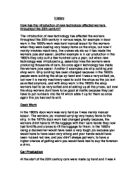The economic prosperity of India in the 20th and 21st century was by and large due to the economic prosperity of the BEIC and the concept of globalization they left in their place.
How did the British Raj and the BEIC effectively globalize the Indian market and what follow through effects did this have on the country?
Before the globally felt effects of the recession, India and its economy were growing at an outstanding rate, measuring a GDP growth rate of 9.1% for the fiscal year 2007–2008 which makes its growth the second fastest among emerging economies in the world, after China (Journal, 2008). But how did an internally volatile nation ruled by tribal monarchies rise up to become one of the economical leaders of the 21st Century? The answer lies in the occupation of India by the British imperialists and the BEIC. However these advancements in the Indian economy on a nation level have had their costs, of which most could consider an ethical moot point. To put it simply: the recent economic prosperity that was brought about by the British occupation of India whilst contributed to the enormous economic success of modern-day India, was at the expense of India’s people, it’s economy and its natural resources which were exploited for British gain during occupation.
Nobody can deny, the changes made to the economy in post-British India have been impressive in nature and enormous in size. However the British East India Company bore their seeds into a tribal culture, one of only recent British colonialism endeavours. Why did the British risk so much, for such country? The Indian economy in pre-colonial era was not recorded as well as many other countries around the time; however estimates put the Indian revenue at £17 Million in the year 1600, vastly larger than recorded British revenue in 1800 at £16 Million. This ‘gold mine’ of economic prosperity was run through the Mughal Empire – the Muslim imperialist power on the Indian sub-continent up until mid 1700’s. This potential became evident to the British (leading world power at the time) and thus the country was figuratively ‘invaded’. Agricultural trade was the base point of profit for Indian monarchs, with cotton, minerals and ores, food processing and textiles. While most villages were self sufficient a huge trade circuit had already been establish with neighbouring and even remote countries. During this period, the revenue made the country was handled through the monarch (Nawab), and the distribution was at his discretion. Although this form could be considered somewhat crude by western standards; with no land owners and no capitalist ambition for profits, it followed beliefs of the Indian culture; and it was working.







